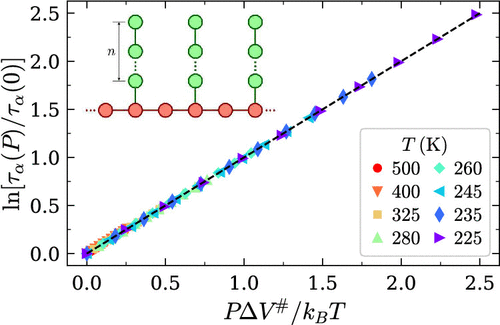当前位置:
X-MOL 学术
›
Macromolecules
›
论文详情
Our official English website, www.x-mol.net, welcomes your
feedback! (Note: you will need to create a separate account there.)
Understanding Activation Volume in Glass-Forming Polymer Melts via Generalized Entropy Theory
Macromolecules ( IF 5.1 ) Pub Date : 2020-08-19 , DOI: 10.1021/acs.macromol.0c01269 Wen-Sheng Xu 1 , Jack F. Douglas 2 , Wenjie Xia 3 , Xiaolei Xu 1
Macromolecules ( IF 5.1 ) Pub Date : 2020-08-19 , DOI: 10.1021/acs.macromol.0c01269 Wen-Sheng Xu 1 , Jack F. Douglas 2 , Wenjie Xia 3 , Xiaolei Xu 1
Affiliation

|
The generalized entropy theory (GET) of glass formation provides an analytic framework for the structural relaxation time and thermodynamic properties of glass-forming polymers in terms of molecular parameters and variable thermodynamic conditions (e.g., variable pressure). Here, we utilize the GET to elucidate the physical nature of the activation volume ΔV# estimated from the leading pressure dependence of the structural relaxation time. We start by analyzing the temperature dependence of ΔV#, for which the predictions from the GET are shown to broadly accord with experimental and simulation results. This analysis is followed by establishing general trends in the variation of ΔV# with molecular parameters describing chain stiffness, cohesive interaction strength, chain length, and monomer structure. Our calculations further show that ΔV# is related to the differential change of the activation free energy as a function of temperature and thus bears a close relationship to the fragility of glass formation. The GET is also used to demonstrate that the variations of fragility and the glass transition temperature Tg with molecular parameters in polymer materials having similar cohesive interaction strength, i.e., a similar chemical nature, can be understood to arise from the relative efficiency of molecular packing near Tg, which we quantify through the experimentally measurable thermal expansion coefficient and isothermal compressibility. A structural understanding of the variation of fragility translates into a better understanding of ΔV# by virtue of the approximate relationship between these properties independently established by the GET.
中文翻译:

通过广义熵理论了解玻璃形成聚合物熔体中的活化体积
玻璃形成的广义熵理论(GET)为形成玻璃的聚合物的结构弛豫时间和热力学性质提供了一个解析框架,涉及分子参数和可变的热力学条件(例如,可变压力)。在这里,我们利用GET阐明了根据结构弛豫时间的超前压力依赖性估算出的活化体积ΔV #的物理性质。我们从分析ΔV #的温度依赖性开始,对于ΔV #而言,从GET得出的预测与实验和仿真结果大致相符。在进行此分析之后,将确定ΔV #的变化的一般趋势。分子参数描述链的刚度,内聚相互作用强度,链长和单体结构。我们的计算进一步表明,ΔV #与活化自由能随温度的微分变化有关,因此与玻璃形成的脆性密切相关。GET还用于证明在具有类似内聚相互作用强度(即类似化学性质)的聚合物材料中,脆性和玻璃化转变温度T g随分子参数的变化可以理解为是由于分子堆积的相对效率引起的接近T g,我们通过实验可测量的热膨胀系数和等温可压缩性进行量化。通过GET独立建立的这些特性之间的近似关系,对脆性变化的结构理解可以更好地理解ΔV #。
更新日期:2020-09-09
中文翻译:

通过广义熵理论了解玻璃形成聚合物熔体中的活化体积
玻璃形成的广义熵理论(GET)为形成玻璃的聚合物的结构弛豫时间和热力学性质提供了一个解析框架,涉及分子参数和可变的热力学条件(例如,可变压力)。在这里,我们利用GET阐明了根据结构弛豫时间的超前压力依赖性估算出的活化体积ΔV #的物理性质。我们从分析ΔV #的温度依赖性开始,对于ΔV #而言,从GET得出的预测与实验和仿真结果大致相符。在进行此分析之后,将确定ΔV #的变化的一般趋势。分子参数描述链的刚度,内聚相互作用强度,链长和单体结构。我们的计算进一步表明,ΔV #与活化自由能随温度的微分变化有关,因此与玻璃形成的脆性密切相关。GET还用于证明在具有类似内聚相互作用强度(即类似化学性质)的聚合物材料中,脆性和玻璃化转变温度T g随分子参数的变化可以理解为是由于分子堆积的相对效率引起的接近T g,我们通过实验可测量的热膨胀系数和等温可压缩性进行量化。通过GET独立建立的这些特性之间的近似关系,对脆性变化的结构理解可以更好地理解ΔV #。









































 京公网安备 11010802027423号
京公网安备 11010802027423号